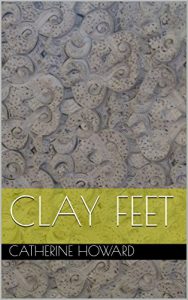Clay Feet is the story of two women from vastly different backgrounds whose paths cross because of a shared love of learning and literature.
Celia is Australian. She is educated, ambitious and troubled by her privilege while at the same time delighting in the life it affords her. She is proud of the position she holds at one of the country’s most prestigious universities and sees her life on a trajectory of her own making. She is hard working, creative and popular. Yet there is a nagging insistence that it is not enough and that she is destined for more.
Setara is Afghan. She is educated, oppressed and troubled by her past. The memories of possibility haunt her day-to-day life. Her longing for learning drove her underground in an ever-suspicious environment. She is courageous, intelligent and independent. Yet she is consistently thwarted in her desire to be and know more by the restrictive regime.
Their paths cross when Celia, in search of something more, finds herself volunteering to work in Afghanistan for a period of twelve months. The role she takes up is as teacher at a school for young woman who have had their education halted during the Taliban rule. It is to this school that Setara eventually comes, on the fringe at first before taking up a place among those much younger. Her aura of mystery is bought into greater relief by the veil that falls softly across her face.
Friendship eventually grows between the two, teacher and student, who are of similar age, have similar interests yet whose life experiences are polar opposites. Neither woman can truly comprehend the life of the other, however a common love of learning in general and literature in particular bridges these differences.
Eventually, Celia returns to her life in Australia believing that it was she who had gained much more from her time volunteering than those for whom she volunteered. Life was just returning to normal when she is woken by a late night call that changed it and her forever.
Setara had chosen freedom over fear, deciding to seek asylum in the land that Celia had painted as one that valued the rights of the individual and encouraged freedom of opinion, faith and life-choices. This decision led her to undertake the journey with the aid of people smugglers who sought payment not just in money but also in kind.
When both women’s paths crossed again, Setara was in a detention centre and Celia was catapulted into an unknown and sometimes frightening world. Setara also carried a secret that would explode on both their lives causing one to end too soon and the other to be turned in a direction unimaginable.
Celia is Australian. She is educated, ambitious and troubled by her privilege while at the same time delighting in the life it affords her. She is proud of the position she holds at one of the country’s most prestigious universities and sees her life on a trajectory of her own making. She is hard working, creative and popular. Yet there is a nagging insistence that it is not enough and that she is destined for more.
Setara is Afghan. She is educated, oppressed and troubled by her past. The memories of possibility haunt her day-to-day life. Her longing for learning drove her underground in an ever-suspicious environment. She is courageous, intelligent and independent. Yet she is consistently thwarted in her desire to be and know more by the restrictive regime.
Their paths cross when Celia, in search of something more, finds herself volunteering to work in Afghanistan for a period of twelve months. The role she takes up is as teacher at a school for young woman who have had their education halted during the Taliban rule. It is to this school that Setara eventually comes, on the fringe at first before taking up a place among those much younger. Her aura of mystery is bought into greater relief by the veil that falls softly across her face.
Friendship eventually grows between the two, teacher and student, who are of similar age, have similar interests yet whose life experiences are polar opposites. Neither woman can truly comprehend the life of the other, however a common love of learning in general and literature in particular bridges these differences.
Eventually, Celia returns to her life in Australia believing that it was she who had gained much more from her time volunteering than those for whom she volunteered. Life was just returning to normal when she is woken by a late night call that changed it and her forever.
Setara had chosen freedom over fear, deciding to seek asylum in the land that Celia had painted as one that valued the rights of the individual and encouraged freedom of opinion, faith and life-choices. This decision led her to undertake the journey with the aid of people smugglers who sought payment not just in money but also in kind.
When both women’s paths crossed again, Setara was in a detention centre and Celia was catapulted into an unknown and sometimes frightening world. Setara also carried a secret that would explode on both their lives causing one to end too soon and the other to be turned in a direction unimaginable.






